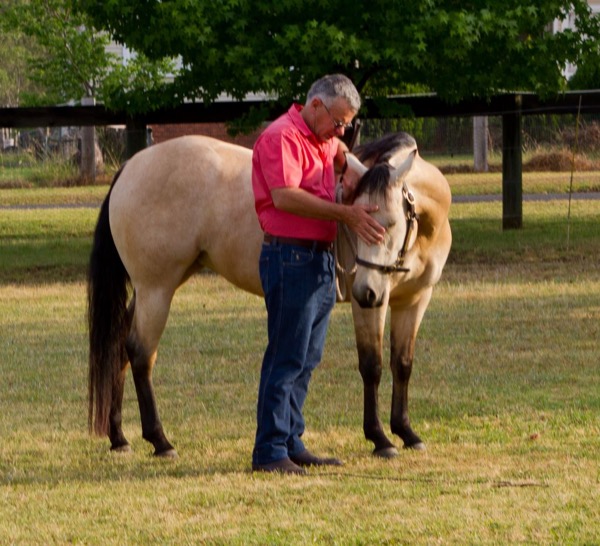My wife Christine always spent lots of time rubbing and scratching her horses.
Our grey horse ‘Kip’ soon learned to come to her and present the spot that he wanted rubbed or scratched.
Sometimes it was his rump, sometimes his ribs, withers, neck or head.
He’d back up to Chris to have his tail scratched.
Kip even learned to back up and lift one hind leg so Chris could scratch between his legs.
Kip trained Chris to scratch or rub whichever part of himself he chose.
He obviously enjoyed it and he controlled exactly when and where she had to scratch.
Whether he was caught or free, Kip moved with Chris and kept presenting the part that he wanted scratched.
Kip also ‘recruited’ my brother Jim for the special task of scratching inside his ears.
The horse would stand with his head lowered while Jim scratched the inside of his ear for minutes at a time.
When Kip was ready, he’d move his head for Jim to scratch inside his other ear.
Without lead or halter, Kip learned to enjoy being scratched inside his ears, between his back legs and all over his head and body.
Horses often have a favourite tree to rub and scratch on.
They back up and rub their rump and tail.
They rub their ribs, shoulders, neck and head with obvious pleasure and I’ve seen many trees worn smooth from these activities.
Scientists have taken a small part of this horse scratching and applied it to horse training.
Having observed horses scratching each other’s withers, scientists set out to ‘prove’ that a horse’s withers is indeed the best place for a human to scratch for training purposes.
They say that scratching a horse’s withers calms the horse and lowers his heart rate.
Because of these studies, scientists say that there’s no benefit in rubbing or scratching any other area on a horse.
It’s great that scientists are trying to find better ways to handle and train horses.
The trouble is that many scientific studies aren’t neutral observations.
Many studies I’ve read set out to ‘prove’ a pre-existing theory or idea.
And once a study has been published, it becomes gospel and no one questions it.
Instead of trying to make horse training fit pre-conceived ideas, I feel that scientists should question the established theories and training techniques.
They should try to find what works best for horses in every situation.
I’ve handled thousands of horses and in doing so, I guess I’ve conducted tens of thousands of ‘experiments’.
I’ve learned that my most valuable training tool is simply rubbing a horse’s head.
See how I use this simple rub to build a horse’s confidence in my Starting a Horse Under Saddle Online Clinic.
In his early lessons, every horse will be frightened when your hand first comes near him and no doubt his heart rate will go up.
After a few lessons however, horses learn to enjoy having their head, neck and around their ears rubbed.
It becomes a pleasant and relaxing experience for every horse.
There are many advantages in rubbing a horse’s head.
You can use it to teach your horse to keep his head with you and follow.
You can use it to teach your horse to step forward to you and to step over obstacles.
You can use it to teach him to walk a circle. You can use it to teach him to stand, to bend his neck and to keep his head with you when you stand at his shoulder.
You can use it to mount for the first time, handle his legs, saddle him, introduce new items, treat a wound and just about everything else you want to do.
Most importantly, your horse will learn that it’s a pleasant experience when he’s with you.
He’ll learn to relax and then you can work on building his confidence.
Once a horse is relaxed and confident, it’s very easy to teach him.
The evidence is before you every time you work with your horse.
You don’t need scientific studies to know when a horse is frightened, sweating and distressed.
Time and time again, the evidence is ignored or excused by trainers and their audience.
Every time a horse rushes away, kicks, rears, bucks or strikes, the evidence is quite plain – the lesson isn’t working.
It’s high time for everyone to look at the evidence before them, instead of blindly accepting the stories told by some horse gurus.

